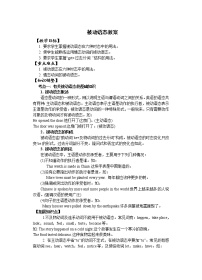

中考英语一轮复习专题复习教案情态动词(含答案)
展开情态动词教案
【教学目标】
1. 要求学生能说出情态动词的分类及用法,掌握情态动词在一般疑问句中的问与答,会熟练做题。
2. 要求学生能进行情态动词的辨析,掌握情态动词表示猜测的用法,并熟练做题。
【教学重点难点】
情态动词can, may, must, ought to , will, shall, should, would , need, dare的用法
【知识梳理】
考点一:情态动词的分类及用法
1. can/could的基本用法:
⑴ 表示体力或智力上的能力,即“能够,会”,可与be able to转换,过去时是could。
例:He can speak English. = He is able to speak English.
—Can you play basketball? — No, I can’t.
如果表示将来具备的能力,要用will be able to。
例:If I have a good sleep, I will be able to do the problem.
⑵ 表示许可,主要用于口语,书面语一般用may。
例:—Can we go home now, please?
— No, you can’t.
2. may/might的基本用法:
⑴ 表示“许可”,用can比较口语化,过去时是might。
例:You may / can come if you wish. 如果你想来,你就来。
You may not pick flowers in this park. 本公园内不许摘花。
(may not表示按规定不许可,如果用mustn’t则表示说话人不许可。)
—May I smoke here? 我可以在这里抽烟吗?
—No, you mustn’t. 不行。(mustn’t表示明确的禁止。)
⑵ 肯定句中表示推测,“可能”。
例:It may rain tomorrow. 明天可能会下雨。
The news may not be true. 这个消息可能不会是真的。
注意:如果在疑问句中表示“可能”,通常用can。
例:Can it be true? 那会是真的吗?
Who can he be? 他究竟是谁呢?
⑶ 【注意】:—May I/we……?
—Yes, you may./—No, you mustn’t.
3. must的基本用法:
⑴ 表示必须,强调说话人的主观意志。
例:I must go now, or I’ll be late.
You must be here by ten o’clock.
【注意】:表示“必须“时,must的否定式为needn’t,或don’t have to, 而不是mustn’t。
也就是:—Must I/we do it now?
—Yes, you must .
—No, you needn’t /don’t have to .
例:—Must I go with them?
—No, you needn’t.
⑵ 表示推测,一般只用于肯定陈述句,表示非常肯定。
例:She didn’t look at me. She must be angry. 她不朝我看,一定是生气了。
4. have to的基本用法:
have to可视为情态动词,但它与其他情态动词在用法上稍有不同。其他情态动词没有人称和数的变化,而have to却有人称和数的变化,要视主语不同而变化。
例:I / You / We / They have to….
He / She / It has to….
You don’t have to….
Does she have to…?
have to =have got to,意思是“必须,不得不”。
和must不同之处:must强调主观需要
have to强调客观需要。
例:Sorry, I have to leave now. 对不起,现在我得走了。
I’ve got to go to a meeting. 我得去参加一个会议。
Will he have to work deep into the night? 他将不得不工作到深夜吗?
5. need的基本用法:
need的基本词义是“需要”,它既可作情态动词,又可作实义动词。
⑴ need用作情态动词时,只用于否定句和疑问句。它只有一种形式,后接动词原形。例:I don’t believe you need worry. 我相信你没有必要焦急。
—Need we go so soon? 我们需要这么早就去吗?
— Yes, we must. / No, we needn’t. 是的,必须。/不,不必。
So I needn’t tell him, need I? 所以我不需要告诉他,对吧?
请比较以下两句话的不同意思:
You needn’t buy the coat. 你没有必要买那件外衣。(你还没买)
You needn’t have bought the coat. 你没有必要买这件外衣的。(而你却买了)
【注意】:—Need I/we……?
—Yes,you must ./—No, you needn’t / don’t have to.
⑵ need用作实义动词时,有时态、人称和数的变化。
如果人作主语,一般后接带to的动词不定式。即need to do sth;
如果物作主语,一般后用need to be done 或need doing sth。
例如:I need to look up this word in the dictionary.
My watch needs mending/to be mended. 我的手表需要修理了。
We don’t need to work today. (= We needn’t work today.)
Does he need to go right now? (= Need he go right now?)
6. shall的基本用法:
1)表征询意见,用于第一、第三人称疑问句。
Shall I get some tea? 我给你点茶好吗?
2)表说话人的意愿,有“命令、允诺、警告、决心”等意思,用于第二、第三人称陈述句。
You shall do as I say. 按我说的做。(命令)
7. will/would的基本用法:
will
1)表意愿,用于各种人称陈述句。
I will do anything for you. 我愿为你做任何事。
2)表请求,用于疑问句。
Will you close the window? It’s a bit cold. 请你把窗户关上好吗?有点冷。
3)表示某种倾向或习惯性动作。
Fish will die out of water. 鱼离开水就不能活。
would
1)表意
I said I would do anything for you. 我说过我愿意为你做任何事。
2)表委婉地提出请求、建议或看法。
Would you like another glass of beer? 再来杯啤酒好吗?
3)表过去反复发生的动作或过去的一种倾向。
Every time she was in trouble, she would go to him for help.
她每遇到麻烦都会向她求助。他告诉我盒子打不开了。
8.ought to/used to的基本用法:
ought to:
1)表义务,意为“应该”(因责任、义务等该做),口气比should稍重。
You are his father. You ought to take care of him. 你是他父亲,应当管他。
2)表推测,暗含很大的可能,语气较弱。
Han Mei ought to know his telephone number. 韩梅该知道他的电话号码。
考点二:情态动词的辨析
1.must和have to
两者都表示“必须”的意思,但must含有说话人主观上的看法、态度;have to则表示客观上的需要。
【考例1】—Must we finish giving out the posters today?
—Yes, we _______. It can’t be put off any longer. [太原]
A. can B. may C. must [答案]C
【考例2】—I didn’t pass the math test. I think I have spent too much time playing computer games recently.
—I agree. You_______ play like that any more. [河南]
A. needn’t B. mustn’t C. may not D. wouldn’t [答案]B
【考例3】When traffic lights are red. We _________stop and wait. [南京]
A. may B. can C. must D. might. [答案]C
【考例4】—I really like playing computer games!
—I’m afraid you ________stop,for your study and your health. [宜昌]
A. am B. will C.may D.must [答案]D
2.can和could
两者都可用来表能力,意为“能够,会”;可用来表示许可(常用在口语中)或表示怀疑、惊异、不相信等态度(常用于否定句、疑问句或感叹句中)。
【考例1】—Could I borrow your dictionary?
—Of course you ____________.[陕西]
A. can B. must C. should D. will [答案]A
【考例2】—Listen! Is Tom singing in the classroom?
—No. It ________be Tom. He has gone to Paris. [长沙市]
A. may not B. needn’t C. can’t [答案]C
【考例3】—Mary, ________ you speak Chinese? —Yes, only a little. [北京]
A. must B. need C. may D. can [答案]D
3.shall和should
shall用于第一、三人称疑问句表示征求对方意见;用于第二、三人称肯定句或否定句表示说话人给予对方的“禁止、命令、警告、允诺或威胁等”。
should用来表示建议、责任、义务时,可译为“应该,应当”,此时可用ought to替换;可用来表示惊讶、忧虑、赞叹等不满情绪(用在疑问句中);还可用来委婉地陈述自己的意见。
【考例】Schools _________allow students at least one hour a day for sports. [安徽]
A. would B. might C. should D. could [答案]C
4.had better和would rather
“had better+动词原形”意为“最好做……”,否定句式为had better not。“would rather+动词原形”意为“宁可,宁愿”,否定句式为would rather not。
【考例1】—Bob,may I ________your MP4?
—Sure.But you’d better not _________it to others.[福州]
A. end;lend B lend;borrow C. borrow;borrow D. borrow;lend
[答案]D
【考例2】—What about playing football this afternoon, Sam?
—I would rather ______ at home than football. It’s too hot outside. [南京]
A. stay; playing B. stay; play C. to stay; to play D. to stay; playing
[答案]:B
考点三:考查情态动词表推测的用法
对现在或将来的推测用“情态动词+动词原形”。
肯定的推测一般用must,should,may (might)或can(could),其中,must的语气最强。意为“肯定”、“准是”、“想必是”;should的语气次之,意为“很可能”、“应该”,指按常理推测;may (might),can(could)的语气最弱,意为“有时会”、“也许”、“可能”。否定推测分为两种情况:语气不很肯定时,常用may/might/could not,意为“可能不”、“也许不”;否定语气较强时,则用can’t,意为“根本不可能”、“一定不能”,表示惊异、怀疑的感情色彩。
【考例1】You ________be tired after working for eight hours without a rest. [广东]
A. can B. may C. must D. need [答案]C
【考例2】—Look at the boy running on the ground.Is it Davis?
—It ____be him.I saw him go to the teacher’s office just now.[黄冈]
A. must B. can’t C. could D. might [答案] B
【板书设计】
can/could
may/might
must
have to
分类及用法 need
shall/should
will/would
ought to/used to
情态 must和have to
动词 can和could
辨析 shall和should
had better和would rather
肯定:must>should>may/might/can/could
表示猜测用法
否定:语气不很肯定时,常用may/might/could not
语气较强时,则用can’t。
【教后反思】
|
中考英语一轮复习教案 情态动词【教案】: 这是一份中考英语一轮复习教案 情态动词【教案】,共5页。教案主要包含了教学目标,教学重点难点,知识梳理,板书设计,教后反思等内容,欢迎下载使用。
初中英语中考复习 中考英语专题复习 情态动词【教案】: 这是一份初中英语中考复习 中考英语专题复习 情态动词【教案】,共5页。教案主要包含了教学目标,教学重点难点,知识梳理,板书设计,教后反思等内容,欢迎下载使用。
初中英语中考复习 中考英语一轮专题复习 动词时态【教案】: 这是一份初中英语中考复习 中考英语一轮专题复习 动词时态【教案】,共6页。教案主要包含了教学目标,教学重点难点,知识梳理,板书设计,教后反思等内容,欢迎下载使用。














